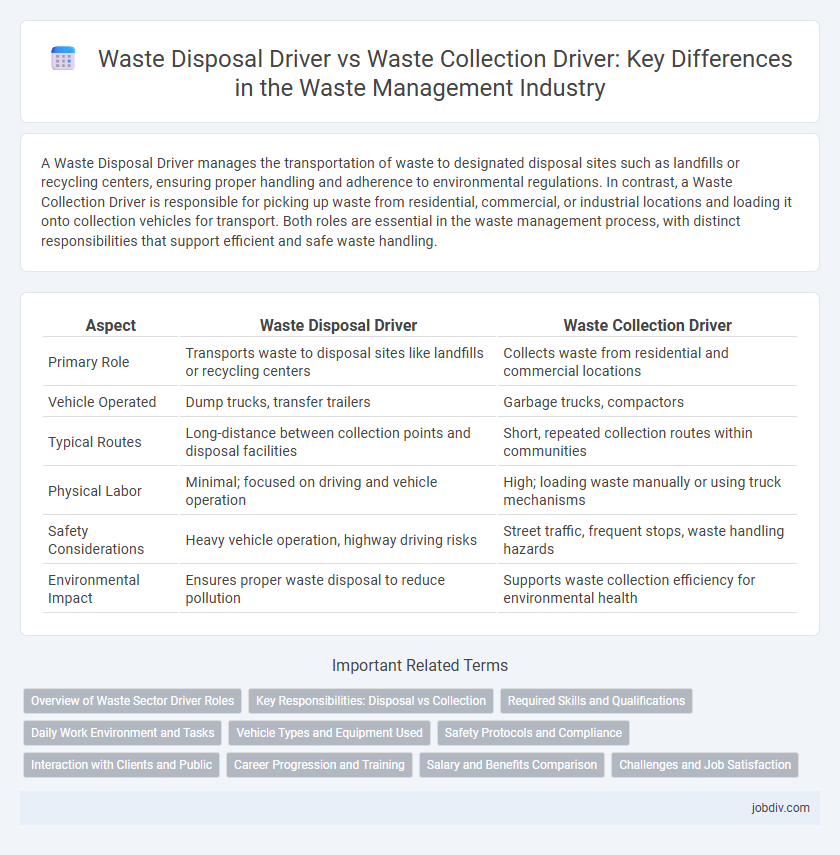A Waste Disposal Driver manages the transportation of waste to designated disposal sites such as landfills or recycling centers, ensuring proper handling and adherence to environmental regulations. In contrast, a Waste Collection Driver is responsible for picking up waste from residential, commercial, or industrial locations and loading it onto collection vehicles for transport. Both roles are essential in the waste management process, with distinct responsibilities that support efficient and safe waste handling.
Table of Comparison
| Aspect | Waste Disposal Driver | Waste Collection Driver |
|---|---|---|
| Primary Role | Transports waste to disposal sites like landfills or recycling centers | Collects waste from residential and commercial locations |
| Vehicle Operated | Dump trucks, transfer trailers | Garbage trucks, compactors |
| Typical Routes | Long-distance between collection points and disposal facilities | Short, repeated collection routes within communities |
| Physical Labor | Minimal; focused on driving and vehicle operation | High; loading waste manually or using truck mechanisms |
| Safety Considerations | Heavy vehicle operation, highway driving risks | Street traffic, frequent stops, waste handling hazards |
| Environmental Impact | Ensures proper waste disposal to reduce pollution | Supports waste collection efficiency for environmental health |
Overview of Waste Sector Driver Roles
Waste disposal drivers primarily transport waste to designated landfill sites, recycling centers, or treatment facilities, ensuring proper segregation and compliance with environmental regulations. Waste collection drivers operate collection vehicles that gather residential, commercial, or industrial waste from various locations, often managing routes and schedules for efficient pickup. Both roles are critical in maintaining sanitation, supporting waste management infrastructure, and contributing to sustainability efforts within the waste sector.
Key Responsibilities: Disposal vs Collection
Waste disposal drivers primarily manage the transportation of waste to designated disposal sites such as landfills, recycling centers, or incineration facilities, ensuring proper handling and compliance with environmental regulations. Waste collection drivers focus on the efficient pickup and loading of waste from residential, commercial, or industrial locations, maintaining schedules and adhering to safety protocols. Both roles require knowledge of waste management practices but differ in operational routes and end-point responsibilities.
Required Skills and Qualifications
Waste disposal drivers require skills in operating heavy machinery, understanding environmental regulations, and managing hazardous materials to ensure safe and compliant waste disposal. Waste collection drivers must possess strong route navigation abilities, physical stamina for loading, and knowledge of local waste segregation and recycling protocols. Both roles demand valid commercial driver's licenses, safety training certifications, and adherence to occupational health and safety standards.
Daily Work Environment and Tasks
Waste Disposal Drivers operate in waste processing facilities, handling the transport of compacted refuse to landfills or recycling centers, requiring familiarity with heavy machinery and strict safety protocols. Waste Collection Drivers navigate urban or suburban routes, manually or mechanically emptying residential and commercial bins, often interacting with the public and adhering to tight schedules. Both roles demand physical stamina and adherence to environmental regulations but differ in task complexity and operational environments.
Vehicle Types and Equipment Used
Waste disposal drivers primarily operate rear-loader and compactor trucks equipped with hydraulic lifts and automated arms designed for unloading and compressing waste at disposal sites. Waste collection drivers use front-loader and side-loader trucks featuring grapple arms or automated bin lifters to efficiently collect and transport residential or commercial refuse. Both roles require specialized vehicles optimized for safe waste handling and efficient route management.
Safety Protocols and Compliance
Waste Disposal Drivers adhere strictly to safety protocols involving the secure handling and transportation of hazardous materials, ensuring compliance with environmental regulations like the Resource Conservation and Recovery Act (RCRA). Waste Collection Drivers focus on safe loading techniques, proper use of personal protective equipment (PPE), and adherence to local waste management ordinances to prevent injuries and contamination. Both roles require comprehensive training on waste segregation, vehicle operation, and emergency response to maintain occupational safety and regulatory compliance.
Interaction with Clients and Public
Waste disposal drivers primarily interact with facility personnel and regulatory inspectors, ensuring proper unloading and compliance with disposal protocols. Waste collection drivers engage directly with residents, businesses, and public spaces, managing waste pickup schedules, addressing customer inquiries, and promoting community cleanliness. Effective communication skills and professional demeanor are essential for both roles to maintain positive client relationships and public trust.
Career Progression and Training
Waste Disposal Drivers operate specialized trucks for transporting waste to treatment or landfill sites, requiring advanced training in vehicle handling and safety protocols, which enables career progression into supervisory or logistics roles within waste management. Waste Collection Drivers primarily focus on residential or commercial waste pickup, with foundational training in route navigation and customer interaction, often leading to opportunities in fleet coordination or route planning. Both roles benefit from continuous professional development, with Waste Disposal Drivers typically advancing faster due to the complexity of disposal operations and regulatory compliance.
Salary and Benefits Comparison
Waste disposal drivers typically earn a higher salary than waste collection drivers due to the specialized skills required for operating heavy machinery and handling hazardous materials. Benefits for waste disposal drivers often include comprehensive health insurance, overtime pay, and retirement plans, reflecting the job's increased risk and complexity. In contrast, waste collection drivers may receive standard benefits packages with lower base pay but opportunities for bonus incentives based on route efficiency and punctuality.
Challenges and Job Satisfaction
Waste disposal drivers face challenges such as maneuvering heavy trucks in confined spaces and managing hazardous materials, which can impact job satisfaction due to safety concerns. Waste collection drivers often deal with tight schedules and physically demanding routes, but experience higher job satisfaction from consistent daily interaction and active community service. Both roles require strong attention to detail and adherence to regulations, influencing their overall work environment and fulfillment.
Waste Disposal Driver vs Waste Collection Driver Infographic

 jobdiv.com
jobdiv.com